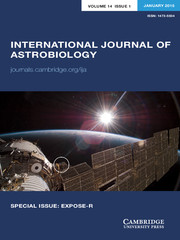Crossref Citations
This article has been cited by the following publications. This list is generated based on data provided by
Crossref.
Guzman, Marcelo I.
and
Martin, Scot T.
2009.
Prebiotic Metabolism: Production by Mineral Photoelectrochemistry of α-Ketocarboxylic Acids in the Reductive Tricarboxylic Acid Cycle.
Astrobiology,
Vol. 9,
Issue. 9,
p.
833.
Guzman, Marcelo I.
and
Martin, Scot T.
2010.
Photo-production of lactate from glyoxylate: how minerals can facilitate energy storage in a prebiotic world.
Chemical Communications,
Vol. 46,
Issue. 13,
p.
2265.
Guzman, Marcelo I.
2011.
Origins of Life: The Primal Self-Organization.
p.
85.
Soares, Ana R. M.
Taniguchi, Masahiko
Chandrashaker, Vanampally
and
Lindsey, Jonathan S.
2012.
Primordial Oil Slick and the Formation of Hydrophobic Tetrapyrrole Macrocycles.
Astrobiology,
Vol. 12,
Issue. 11,
p.
1055.
Wang, Wei
Li, Qiliang
Yang, Bin
Liu, Xiaoyang
Yang, Yanqiang
and
Su, Wenhui
2012.
Photocatalytic reversible amination of α-keto acids on a ZnS surface: implications for the prebiotic metabolism.
Chemical Communications,
Vol. 48,
Issue. 15,
p.
2146.
Egel, Richard
2012.
Primal Eukaryogenesis: On the Communal Nature of Precellular States, Ancestral to Modern Life.
Life,
Vol. 2,
Issue. 1,
p.
170.
Wang, Wei
Liu, Xiaoyang
Yang, Yanqiang
and
Su, Wenhui
2013.
Reversible transformation between α-oxo acids and α-amino acids on ZnS particles: a photochemical model for tuning the prebiotic redox homoeostasis.
International Journal of Astrobiology,
Vol. 12,
Issue. 1,
p.
69.
Zhou, Ruixin
and
Guzman, Marcelo I.
2014.
CO2 Reduction under Periodic Illumination of ZnS.
The Journal of Physical Chemistry C,
Vol. 118,
Issue. 22,
p.
11649.
Ranjan, Sukrit
and
Sasselov, Dimitar D.
2016.
Influence of the UV Environment on the Synthesis of Prebiotic Molecules.
Astrobiology,
Vol. 16,
Issue. 1,
p.
68.
Zhou, Ruixin
and
Guzman, Marcelo I.
2016.
Photocatalytic Reduction of Fumarate to Succinate on ZnS Mineral Surfaces.
The Journal of Physical Chemistry C,
Vol. 120,
Issue. 13,
p.
7349.
Zhou, Ruixin
Basu, Kaustuv
Hartman, Hyman
Matocha, Christopher J.
Sears, S. Kelly
Vali, Hojatollah
and
Guzman, Marcelo I.
2017.
Catalyzed Synthesis of Zinc Clays by Prebiotic Central Metabolites.
Scientific Reports,
Vol. 7,
Issue. 1,
Ranjan, Sukrit
and
Sasselov, Dimitar D.
2017.
Constraints on the Early Terrestrial Surface UV Environment Relevant to Prebiotic Chemistry.
Astrobiology,
Vol. 17,
Issue. 3,
p.
169.
Eugene, Alexis J.
Pillar-Little, Elizabeth A.
Colussi, Agustín J.
and
Guzman, Marcelo I.
2018.
Enhanced Acidity of Acetic and Pyruvic Acids on the Surface of Water.
Langmuir,
Vol. 34,
Issue. 31,
p.
9307.
Springsteen, Greg
Yerabolu, Jayasudhan Reddy
Nelson, Julia
Rhea, Chandler Joel
and
Krishnamurthy, Ramanarayanan
2018.
Linked cycles of oxidative decarboxylation of glyoxylate as protometabolic analogs of the citric acid cycle.
Nature Communications,
Vol. 9,
Issue. 1,
Toparlak, O Duhan
and
Mansy, Sheref S
2019.
Progress in synthesizing protocells.
Experimental Biology and Medicine,
Vol. 244,
Issue. 4,
p.
304.
2019.
Plant Cell Biology.
p.
497.
Muchowska, Kamila B.
Chevallot-Beroux, Elodie
and
Moran, Joseph
2019.
Recreating ancient metabolic pathways before enzymes.
Bioorganic & Medicinal Chemistry,
Vol. 27,
Issue. 12,
p.
2292.
Zhang, Fubao
Wang, Xianming
Liu, Haonan
Liu, Chunli
Wan, Yong
Long, Yunze
and
Cai, Zhongyu
2019.
Recent Advances and Applications of Semiconductor Photocatalytic Technology.
Applied Sciences,
Vol. 9,
Issue. 12,
p.
2489.
Mangiante, David
Schaller, Richard D.
Banfield, Jillian F.
and
Gilbert, Benjamin
2019.
Pathways for the Photoreduction of Fumarate on ZnS.
ACS Earth and Space Chemistry,
Vol. 3,
Issue. 10,
p.
2250.
Li, Yu-Xuan
Fu, Huifen
Wang, Peng
Zhao, Chen
Liu, Wen
and
Wang, Chong-Chen
2020.
Porous tube-like ZnS derived from rod-like ZIF-L for photocatalytic Cr(VI) reduction and organic pollutants degradation.
Environmental Pollution,
Vol. 256,
Issue. ,
p.
113417.




